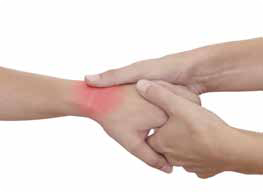
Wrist pain can be a challenging problem to treat. This is especially true with regard to complex regional pain syndrome (CRPS) of the wrist. It is a condition that remains poorly understood but has the hallmark symptom of pain.
Wrist CRPS causes a persistent burning pain in the wrist—often following a minor injury or even surgery. The pain tends to be out of proportion to what is expected. For instance, you might strain your wrist, but it could feel like you have received a major burn. Other symptoms include abnormal sweating; skin sensitivity, such as intense pain from a slight touch; pain spreading to other parts of the body; pain response from temperature changes; swelling and sti ffness; and skin color changes.
The cause of wrist CRPS remains unknown. One theory is that genetics could increase the risk. Other theories include psychological, environmental and physical factors. People who suff er from anxiety and depression are more likely to have wrist CRPS, but not everyone fi ts this profi le. Ultimately, a person with wrist CRPS has pain receptors that are too sensitized or over-stimulated. Simple external stimuli result in signifi cant pain.
If you su er from wrist CRPS, treatment is usually multidisciplinary. It aims to resolve any psychological factors, as well as the immediate pain. Your treatment may include physical therapy, counseling and/or medication.
Some of the physical therapy treatments include
- desensitization therapy, using tactile pressure to decrease sensitivity
- progressive use of the wrist, using common objects to facilitate normal wrist functioning
- transcutaneous electrical nerve stimulation, known as TENS, to stimulate the nerves for therapeutic purposes to reduce pain signals to the brain.
Counseling can help patients by encouraging a positive outlook. Medications used include painkillers, anti-infl ammatory medications and antidepressants. Injections are another option used to block the pain receptors causing wrist pain. The aim of these treatments is to stop the debilitating cycle of pain, infl ammation and resulting depression that occurs from this chronic condition. With physical therapy in your arsenal of strategies, you can expect a return to your daily activities free of pain.
